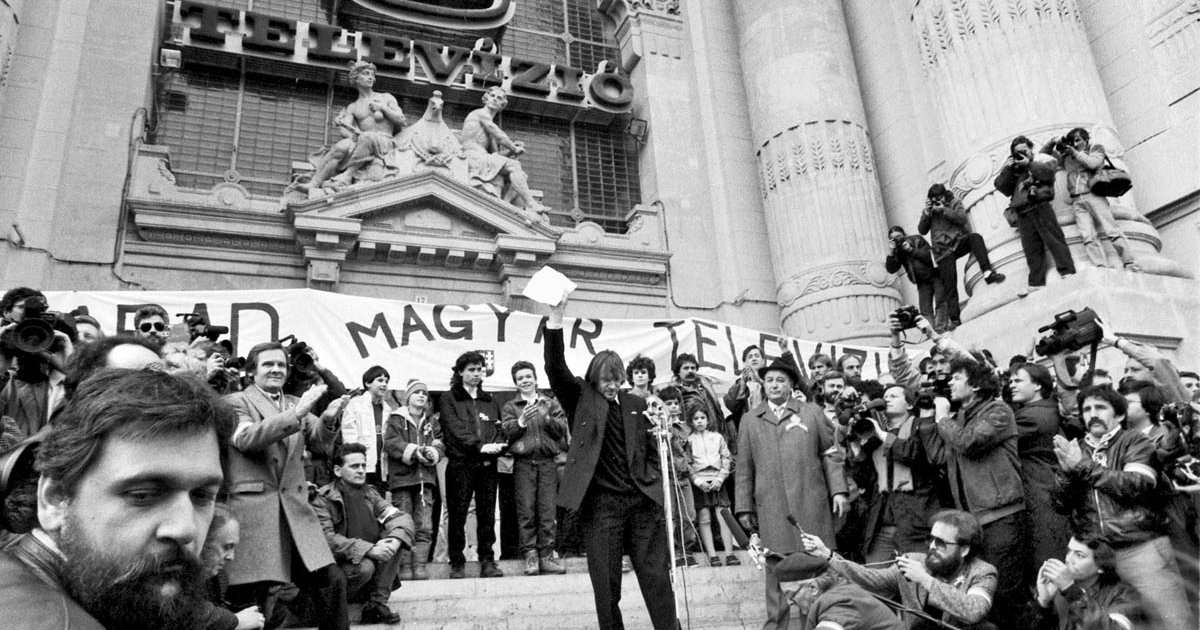Hungarian Television, 1989. 03. 15. – Budapest, Szabadság Square
Fact of the Hungarian figure „Reburial of Imre Nagy (Heroes Square) – 1989”
Part of the „Dreaming about the democracy” topic
On March 15, 1989, Hungarians gathered in Budapest to commemorate the anniversary of the 1848 revolution, a day historically associated with the fight for self-governance and the modernization of Hungarian society. This national memorial day, filled with progressive and revolutionary sentiment, had been suppressed by the communist regime in the 1950s. By the 1960s, the government allowed a hybrid commemoration, combining the 1848 revolution with the Soviet victory over Nazism and the short-lived 1919 Hungarian Soviet Republic. However, 1989 marked the first time in almost 40 years that March 15 was restored as a national holiday, and it became a pivotal moment in Hungary’s transition to democracy.
The Communist Party attempted to co-opt the occasion with a joint commemoration, but opposition groups rejected this, organizing their own mass demonstration instead. Around 100,000 people gathered at key sites in Budapest, including Szabadság Square in front of the Hungarian Television headquarters. At this historic event, opposition leaders read out their demands live on television, calling for the withdrawal of Soviet troops from Hungary, the full rehabilitation of the 1956 revolution, and respect for human rights and democratic freedoms. These demands, broadcast live to the nation, symbolized the growing momentum of Hungary’s democratic movement and the challenge to the communist regime’s authority.
Hungarian Television, a central symbol of state-controlled media, played a significant role in the events of that day. For decades, it had been a tool of the communist regime, shaping public opinion through propaganda and censorship. The live broadcast of the opposition’s demands marked a critical breakthrough in the fight for press freedom, highlighting the role of media in Hungary’s evolving political landscape. The protest on March 15 was a direct challenge to the regime’s control of information and its ability to suppress dissent.
This moment is also linked to Hungary’s broader transition to democracy, notably the reburial of Imre Nagy on June 16, 1989, another key event in the dismantling of the communist regime. Nagy, the leader of the 1956 Hungarian Revolution, had been executed and buried in an unmarked grave, his memory suppressed by the state. His reburial, attended by thousands, was a powerful act of national reconciliation and a public rejection of Hungary’s Soviet-dominated past. Together, the March 15 demonstrations and Nagy’s reburial reflected Hungary’s desire for freedom and democratic reform, signaling the end of communist rule.
Cserhalmi György, a renowned Hungarian actor, played a significant symbolic role during Hungary’s transition to democracy, particularly through his participation in the public events surrounding the 1989 movement for political reform. Known for his powerful performances and deep connection to national identity, Cserhalmi’s involvement lent cultural and intellectual weight to the democratic movement. On March 15, 1989, Cserhalmi took part in the historic demonstrations at Szabadság Square, reading out the opposition’s demands live on Hungarian Television. His voice, familiar and trusted by the Hungarian public, amplified the call for press freedom, the withdrawal of Soviet troops, and the rehabilitation of the 1956 revolution.





